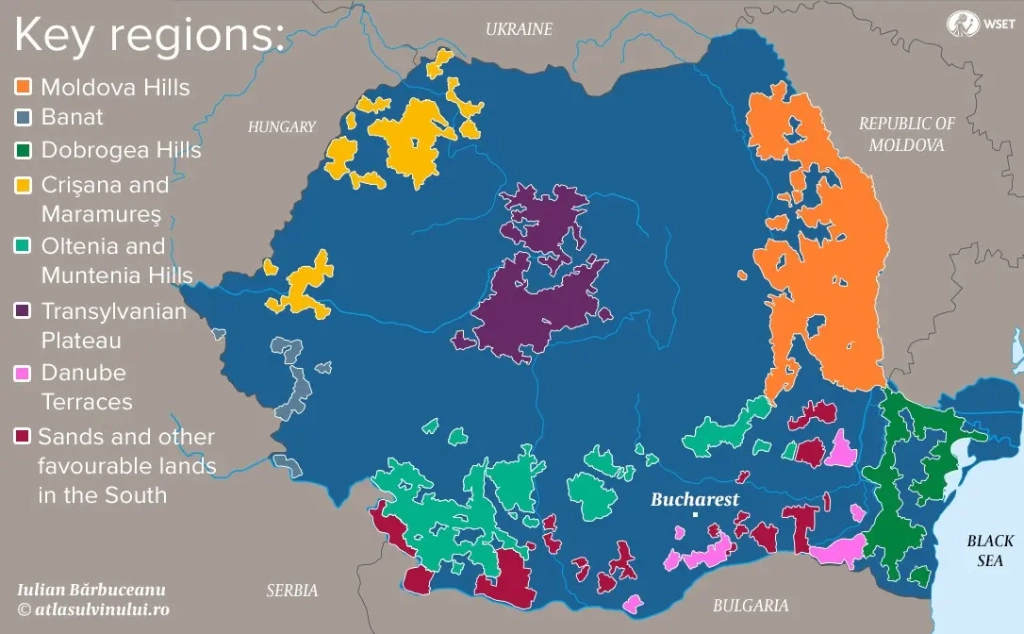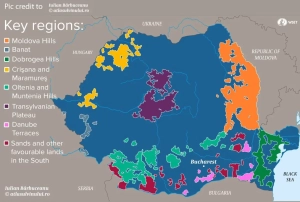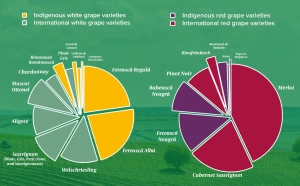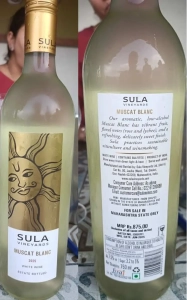
Posted: Thursday, 29 May 2025 23:50
Wine Secrets of Romania
 Romania used to sell wines earlier at very low prices. Quality was not important for the customers who were mostly Russian wine drinkers but price was the prime factor for many years, according to most Romanian wine experts. But after 1991 Europeans have entered the country to take advantage of its huge wine-making potential and conducive investment policies.
Romania used to sell wines earlier at very low prices. Quality was not important for the customers who were mostly Russian wine drinkers but price was the prime factor for many years, according to most Romanian wine experts. But after 1991 Europeans have entered the country to take advantage of its huge wine-making potential and conducive investment policies.
One of the world’s largest wine producers after Italy, France, Spain, Germany and Portugal, Romania is the sixth largest among European wine-producing countries. It produced around 4.5 million hL wine in 1921. It ought to start attracting Indians, not only because of the lower prices but also lower taxes.
History of Wines
Romania has one of the oldest wine-making traditions in the world and its viticulture dates back more than 6,000 years. Due to suitable climate, soils and hilly terrains viticulture became a popular activity especially in the hilly areas.
Several indigenous grape varieties were discovered during medieval times. Till the Phylloxera hit Romania in 187o-80 like other parts of Europe, every Romanian wine region had its own local grapes. Historically, wine has been the traditional alcoholic beverage of Romanians since medieval times.
Restoration of the Romanian viticulture lasted until the beginning of the 20th century, and was done mainly by planting French wine grape varieties. Phylloxera-resistant hybrid grapes were also planted. In fact several traditional Romanian wine grapes did survive the Phylloxera crisis, and are still cultivated.
Romania under communist rule (1944-89)
Wine production was highly industrialized to maximize productivity.
Many indigenous varieties diminished or were uprooted.
Other grape varieties were created through crossings for higher yields
Progress at a slower pace than expected.
Privatization boosted through new laws and select historic estates.
Foreign investment and EU funding contributed to reconstructing wine heritage
Romania on the World Stage
One of the world’s largest wine producers after Italy, France, Spain, Germany and Portugal, Romania is the sixth largest among European wine-producing countries. It produced around 4.5 million hL wine in 1921. It ought to start attracting Indians, not only because of the lower prices but also lower taxes.
Romania has about 187,000 hectares of vine plantations; that ranks it on sixth place between the European wine-producing countries. With a wine production of about 4.5 million hl/year, Romania is the thirteenth largest wine-producing country in the world.
Wine producing regions
Romania is a very hilly country going from North to West through the Eastern region. The country is divided in 8 main regions: Transylvanian Plateau in the central region, Moldova Hills in the North, Muntenia & Olteniei Hills in the South of Romania, Banat Hills, Crisana Hills and Dobruia Hills, around the capital city of Bucharest. The Sandy region in Central-Southern Romania is another region in south Romania.
Grape varieties
Feteascã Neagra is the most popular red variety originally from its friendly northerly neighbor Moldova where its cultivation has been reduced considerably for use. Romania still grows the grape with focus in the eastern part. It is not commercially planted outside Eastern Europe, although the modern trend toward more obscure grape varieties may see this change in coming years, especially for quality grapes and character. It produces dry, semi-dry or sweet wines, with an alcohol content of 12-14%, with deep red colour and ruby shades, with the flavour becoming richer and smoother with ageing.
The most known Romanian white wine grape varieties are Fetească Albă, Crâmpoșie and Fetească Regală. Feteascã Albă and Fetească Regală produce dry or semi-dry wines, with rich floral aromas. They have a moderate alcohol content (11.5 to 12%) and moderate acidity. Crâmpoșie is known for producing fresh and fruity wines, with moderate alcohol content and pronounced acidity
The most cultivated indigenous aromatic varieties are Tămâioasă Romãneascã and Busuioacã de Bohotin.
Each wine-growing region also cultivates international wine grape varieties, mainly Sauvignon Blanc, Riesling, Chardonnay, Pinot Gris and Traminer for whites and Cabernet Sauvignon, Merlot and Pinot Noir for reds.
Wine Labelling
Wines are labelled generally on the basis of common grape varieties though a few better known wineries still use their names on the bottles as the labels. All these local and international varieties form the basis of many wines, presented mainly under the name of the wine grape variety (e.g. Sauvignon, Feteascã Albă, and Tămâioasă Romãneascã) and less commonly under the name of producer. Some producers rely on their popular marketing names as well (e.g. Tignanello, Ornellaia and Masseto in Italy, Vega Sicilia Unico in Spain and Opus One in the US and Grange in Australia.)
Wines

Romania has been known to produce different traditional varieties grown in each region. Each region has its own traditional grape varieties for white, red and aromatic wines. During the previous century the demand was more in Russia for sweet wines and the country focused on sweet and semi-sweet wines which were age-worthy and could mature for more than 50 years or more due to high sugar content. For example Fetească Neagrăfor the Iași wine growing region and Grasă de Cotnari and Francusa for the Cotnari wine-growing region.
Some of the other grape varieties are Zghihara de Husi and Busuioaca de Bohotin Crâmpoșie, Băbeasca Neagră, Iordană di Ardeleancă and Miniș wine-growing region. The names are difficult to pronounce, and as is the practice these days the consumers tend to avoid drinking wines that are difficult to pronounce. All the same, they are truly a connoisseurs’ delight. As one can see many grape varieties even carry the name of the areas where they are cultivated. More details are given in the Wikipedia.
Future of Romanian wines in India
- Hardly known in India at present
- Due to low exports, it is not well known internationally also.
- Negative perceptions caused by collectivization under Communist rule
- Need of wine education about the country and its wines,
- Offer good value for money with growing quality
- With EU-India FTA in sight in a year or two, Price to go down drastically
- Some DOC Producers have formed associations to sell abroad.
- Yet to find a flagship variety, a national brand, or an iconic wine, region or producer to impress the international market. Cotnari is moving in that direction.
Tasting Romanian Wines in the Masterclass with Producers
UBCCR- the Union of Bilateral Chambers of Commerce in Romania has organised an Indo Romanian (INRO) Summit 2025 o 3-4 June at the Pullman Aerocity Hotel where a masterclass is being conducted by Subhash Arora-editor of delWine and President of Indian Wine Academy. Wine Producers from Cotnari will also be present where Wines of Romania and the secrets about their wines will be unraveled as the attendees savour the wines from autochthonous (local) grapes can be savored. There is a fabulous opportunity to taste the complete range of 18 wines.
Subhash Arora




